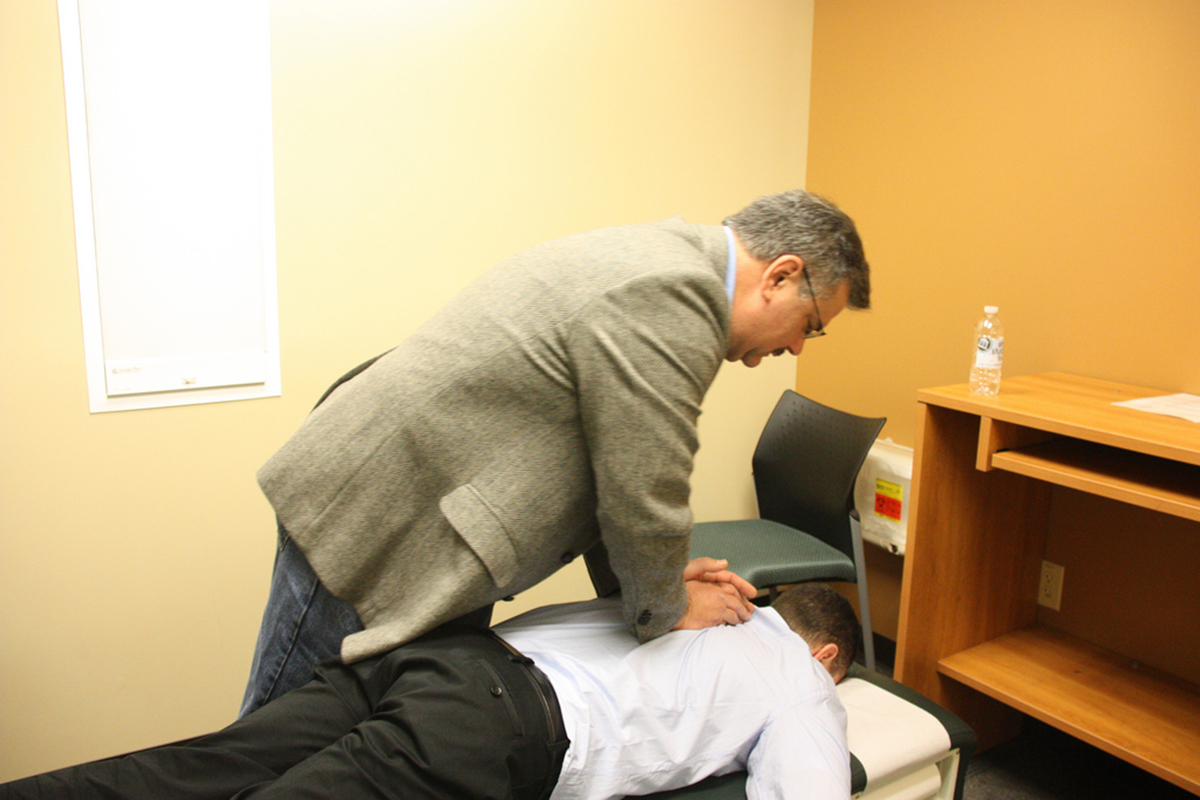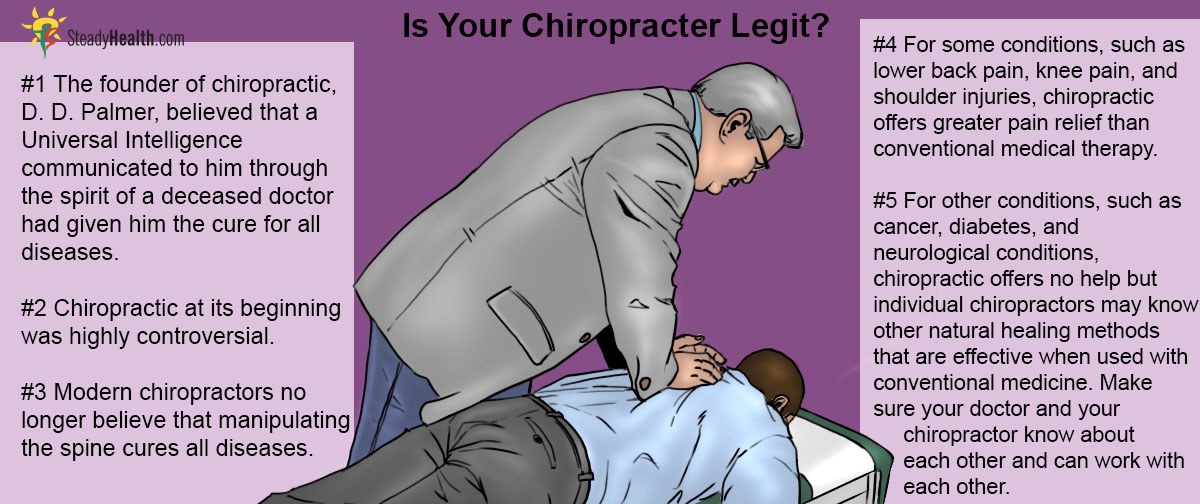One hundred years ago, people seeking healthcare could be forgiven for thinking chiropractic was just a pile of hooey.
The founder of chiropractic medicine, a Canadian-born healer named Daniel David (D.D.) Palmer (1845-1913, had moved from his native Ontario to Davenport, Iowa in 1865. He studied all the fashionable theories of healing of his time, including Spiritualism (consulting the spirits of the dead for their advice in health treatment, Palmer claimed his spirit guide was a deceased physician named Jim Atkinson) and magnetic therapy.
Setting up shop in Davenport, Palmer happened to notice that his building's janitor, Harvey Lillard, suffered a visible lump in his back, as well as deafness. Palmer claimed that he used magnetic therapy to cure the misalignment of Lillard's spine with the unexpected result that Lillard regained his hearing. From this experience Palmer was able to convince thousands of people, including students at his new chiropractic school, that manipulations of the muscles to straighten the spine could cure diseases.
Chiropractic As A Cure-All
In fact, Palmer came to teach that chiropractic could cure all diseases. Borrowing from the then-young discipline of osteopathy, Palmer told his first doctors in training in the late 1890's that the body was a machine, and that mechanical changes in the "machinery" of the body was all that is needed for perfect health.
More specifically, he taught that subluxation, excessive range of motion or what we could call "floppiness" of a joint was the cause of disease, and reducing the range of a joint, putting the tips of bones into alignment, could cure disease — any disease.
The medical establishment that was later to evolve into the American Medical Association did not want Palmer's disciples infringing on their business, and in 1906 Palmer was prosecuted under a new medical arts law for practicing medicine without a license. He chose to go to jail, rather than pay the fine. This necessitated selling the school to his son, B. J. Palmer, for $2,179.96 and a small library with bone specimens.
After 17 days in jail, Palmer decided he would prefer to pay the fine, but his son would not rescind the sale. The elder Palmer then left Iowa and established competing schools of chiropractic in Oklahoma, California, and Oregon, setting up a conflict that would last until the end of his life.
See Also: How to Choose a Chiropractor for Back Pain
Chiropractic As Religion
Isolated from his family, D. D. Palmer became grandiose. In 1911 he wrote a friend:
"(W)e must have a religious head, one who is the founder, as did Christ, Mohamed, Jo. Smith, Mrs. Eddy, Martin Luther and other who have founded religions. I am the fountain head. I am the founder of chiropractic in its science, in its art, in its philosophy and in its religious phase."
Chiropractic: From Farce To Fact
Shortly before dying in 1913, D. D. Palmer wrote in a book about the spiritual duties of a chiropractor:
"By correcting these displacements of osseous tissue, the tension frame of the nervous system, I claim that I am rendering obedience, adoration and honor to the All-Wise Spiritual Intelligence, as well as a service to the segmented, individual portions thereof — a duty I owe to both God and mankind. In accordance with this aim and end, the Constitution of the United States and the statutes personal of California confer upon me and all persons of chiropractic faith the inalienable right to practice our religion without restraint or interference."

Palmer himself, however, did not live to old age. Palmer either was run over by his son's car, or stepped in front of his son's car accidentally, or died of typhoid fever at the age of 68.
Is There Anything Legitimate About Chiropractic?
Over one hundred years after the self-aggrandizing claims of its founder, chiropractic is now practiced by sober, licensed, generally accepted practitioners who get real results in treating a limited number of real conditions.
A study published in the mainstream medical journal Annals of Internal Medicine in 2012 reported that for back and neck pain, chiropractic treatment and exercise are superior to prescription drugs. However, this study found that doing exercises at home was also more beneficial than doctor-prescribed medication.
There have also been studies that found that:
- Adding chiropractic to a treatment program increases relief from knee pain.
- Chiropractic is a useful part of treatment for whiplash.
- Chiropractic effectively treats short-term, acute pain in sciatica.
- Chiropractic is useful in treating short-term and long-term pain from tennis elbow ( lateral epicondylosis), and
- Chiropractic may be useful in treating rotator cuff and shoulder pain.
There is no evidence, however, that chiropractic methods can treat cancer, diabetes, hypertension, cluster headaches, hormonal imbalances, or neurological conditions. Chiropractors may be able to address medical issues affecting those conditions. In some states, chiropractors can even receive additional training that allows them to be certified to supervise natural childbirth and to do minor surgery.
However, if your chiropractor claims, as many have been taught, that Universal Intelligence has dictated that body physiology is maintained by spinal alignment, realize that you are seeing a practitioner whose stock in trade does not have a testable, scientific basis. That doesn't mean that the treatments will have no effect. You can feel subjectively better after receiving a treatment that has no scientific basis.
See Also: Transcranial Direct Current Stimulation Improves Learning Abilities in Pilots
Most chiropractors recognize the limits of their abilities and do an outstanding job of treating problems within their field. If your chiropractor is trying to sell you nutritional supplements or bioidentifcal hormones or herbal medicines, however, ask about the evidence that the treatments work and make sure that your chiropractor and your other doctors can work together for your best results.
- Bronfort G, Evans R, Anderson AV, Svendsen KH, Bracha Y, Grimm RH. Spinal manipulation, medication, or home exercise with advice for acute and subacute neck pain: a randomized trial. Ann Intern Med. 2012 Jan 3
- 156(1 Pt 1):1-10. doi: 10.7326/0003-4819-156-1-201201030-00002.Photo courtesy of kaex0r via Flickr: www.flickr.com/photos/kaex0r414/326926735
- Photo courtesy of Planetc1
- Mind map by SteadyHealth.com



Your thoughts on this